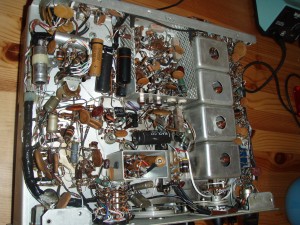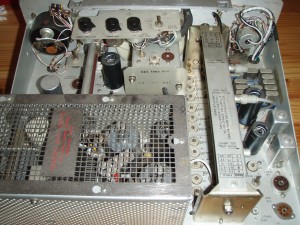
For several years, I have been putting together a Collins S-line station, and earlier this week, I fired it up for the first time. This station was the top of the line, when it was produced in the 1960s, and although there have been plenty of technical innovations along the lines of improved frequency stability, image rejection and DSP, these units still sound great. Now that winter is approaching and the basement is growing chilly, I was more motivated than ever to get this tube equipment on the air.
I have had these radios packed up for quite a few years, not really wanting to ship them all over the world as we moved. Last year, I started putting them back into order. I started by looking through the archive at the Collins Collectors Association and joining their email list. Between the archive and routine access to people who know these rigs inside and out, I came up to speed in no time. I didn’t see anything too amiss on my inspection of the rigs, aside from some carbon residue near the rectifier tube in the power supply. This is a common defect in these supplies — some arcing occurs from the rectifier tube to the metal cabinet, so I wasn’t too worried about that, but realized that the rectifier socket would need to be replaced by a ceramic one down the road.

The most likely items to fail in rigs of this age are the electrolytic capacitors, so I went through each unit and replaced all electrolytic capacitors, plus any paper capacitors and some of the less reliable “black beauty” oil-filled caps. There is some debate about whether it is better to replace preemptively or only when there is evidence of failure, but I leaned towards the preemptive side. While I want to preserve the original engineering, I also want these units to perform well and get some actual on-the-air use. The other obvious thing that can fail are the tubes. Of course, I can’t just run down to the corner store anymore and use their tube tester. To put that statement in context, these radios are just slightly older than I am.
There are a lot of patch cords that run between the station components, some audio, some RF. These and the power plugs and control connectors had degraded to the point that I wanted to replace them. I rebuilt the connecting cords and power cords using the original plugs and sockets, but for everything else, I visited Joel at RF Connection in Gaithersburg, Maryland. Conveniently, his store is about five miles from where I work, and it is packed with every connector, cable and adapter known to man. He also stocks a lot of the materials used in restoring Collins equipment, including replacement feet. Yes, I replaced the little rubber feet, because they also had degraded over time.

After inspecting the units, I took each out of its cabinet and to greater or lesser extent stripped them down. All the tubes came out and everything got a thorough cleaning. All the pots got a shot of deoxit, and other bits of mechanical tune up were performed. I replaced the burnt out panel lights with long life replacements from D.A. Buska Engineers, LLC. These LED lamps should last just about forever, which is good because it is something of a hassle to replace bulbs. It involves my wrist bending in ways that seem unnatural. However, I would think twice about using the LED lights again if I did another restoration. Their light is harsher than the original incandescent lamps, and there is some barely perceptible flicker.
After putting everything together came the smoke test. Since these rigs had been off for more than two decades, I approached this cautiously. I tested each unit separately, bringing power up slowly using a variac (auto-transformer). The power supply came up to voltage and all the supply outputs tested nominal. The receiver also powered up, and when I hooked it up to an antenna, it seemed reasonably sensitive. The band calibrator seemed to work, and put the dial right on WWV. I flipped through the different bands, and could hear signals on all of them.
The transmitter was more complicated. When I got to about 80V on the variac, a thin wisp of grey smoke wafted upwards from the power amplifier section of the transmitter. I couldn’t find where the smoke was coming from, but the take home message was clear — I needed some professional help.
Even if I had not hit this snag, I would have sent the radios in for some professional servicing at this point. After such a long period on the shelf, they were in need of a laboratory realignment, which is beyond what I can do with my current equipment. I also wanted someone who really knew Collins equipment to look them over.
I contacted Peter Wittenburg at Collins Rebuilders. He is located near Annapolis, Maryland, which is close enough that I could carefully pack the rigs in my car and drive them up. It was definitely the right call — the radios got the love and attention that they deserved from an expert. Peter swapped out the rectifier in the power supply, fixed a fairly major problem in the receiver’s permeability-tuned oscillator (not for the faint of heart), replaced a few tubes that had seen their day as well as a few other discrete components that were not up to spec. He ran the rig through its paces and gave me a nice report, that shows by and large, the rigs were seaworthy.

While he was performing his analysis and repairs, I picked up an Asiatic “lollipop” microphone with the proper Collins connector at a hamfest. I had previously borrowed a variac for testing, but decided to purchase one for fulltime use in the station. The Collins equipment was made for a time when the line voltage was lower than the present, and higher voltages will shorten component life. The whole station is now plugged into an isobar strip that itself is plugged into the variac, which maintains voltage at 117V RMS. The station is turned on/off with the isobar rather than each unit’s power knob, as those knobs are all but irreplaceable and are prone to mechanical wearing.
Over last weekend, I made sure that my attic antennas were tuned up, presenting less than a 2:1 vSWR across their useful ranges, as the tube equipment is not tolerant of (read: smokes when confronted with) less well-behaved loads. The ionosphere was revved up as high as it has been in the last decade or so, which boded well. I made my first contact on 40m with WB8PPH (“wb8-pumpkin-pie-headquarters”), who was running a special event station for the Circleville Ohio Pumpkin Festival. I had a few more contacts with PA, IA, and IL and then Sweden, England, Croatia and the Czech Republic on 20m, and Cuba, Honduras, Mexico and finally South Africa on 10m. The received sound quality was golden, and I received favorable reports concerning my audio quality as well.

The rigs can be run in transceiver mode, where the transmitter is slaved to the receiver’s VFO, or they can be run independently, with the both the receiver and transmitter VFOs in action; this is what you would have to do to operate split, for instance, as there is no other RIT/XIT function. Separate operation is also the way to go for CW operation. In transceiver mode, you would hear nothing when zero-beat to the incoming signal (naturally), and the offset in CW mode is 1.3 khz, which is impractically large. To operate CW, I picked a clear frequency and used the “cw-spot” function on the transmitter to send a low-level signal to the receiver, allowing me to adjust them to the same frequency. I did one round of calling (straight key, natch) and had an immediate reply from Northern Ireland and Bulgaria. I had a little difficulty getting the vox-balance right to accomodate semi-breakin operation (some hangtime after transmit so the relays aren’t constantly clicking, but not so much that I miss the reply). According to the overseas stations, there was no problem with key clicks or chirps, so I guess we’re okay on that front as well.
I’ve never been a big fan of sideband, but I got a big kick out of working stations with this rig, and I think I might be spending more time behind the mike this winter.

























